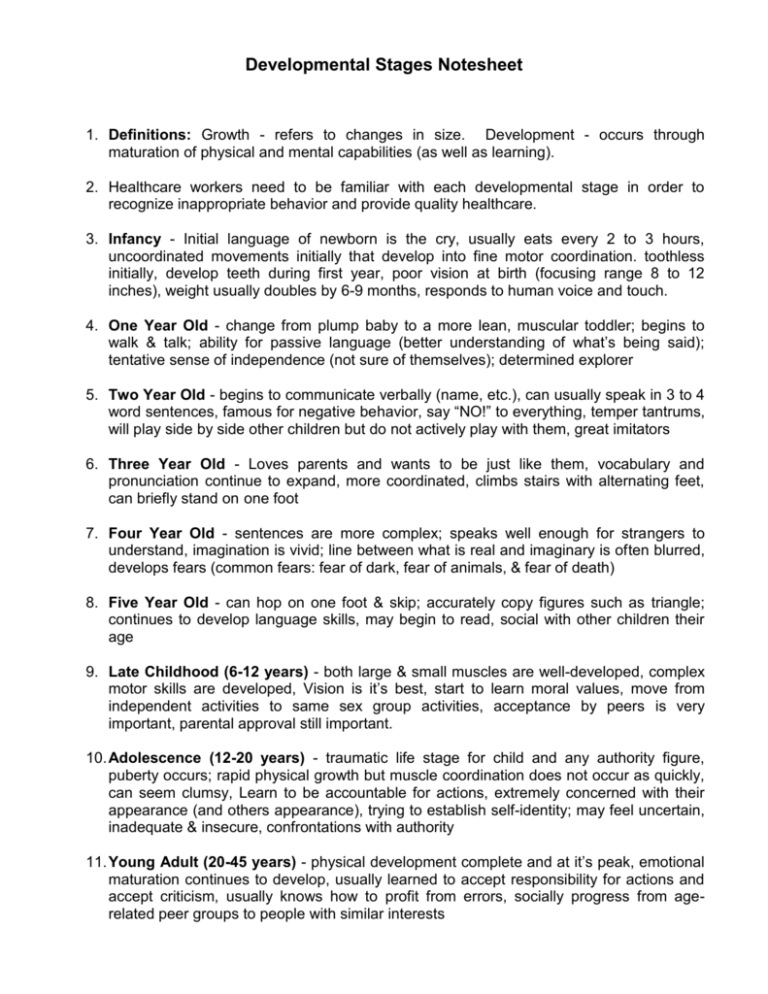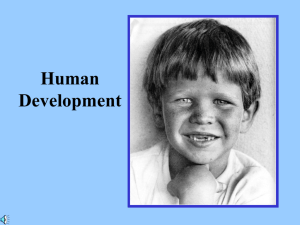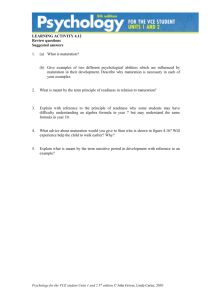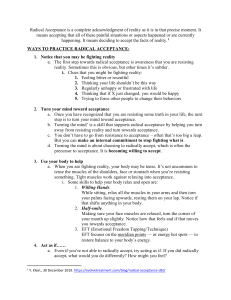Human Growth and Development notesheet
advertisement

Developmental Stages Notesheet 1. Definitions: Growth - refers to changes in size. Development - occurs through maturation of physical and mental capabilities (as well as learning). 2. Healthcare workers need to be familiar with each developmental stage in order to recognize inappropriate behavior and provide quality healthcare. 3. Infancy - Initial language of newborn is the cry, usually eats every 2 to 3 hours, uncoordinated movements initially that develop into fine motor coordination. toothless initially, develop teeth during first year, poor vision at birth (focusing range 8 to 12 inches), weight usually doubles by 6-9 months, responds to human voice and touch. 4. One Year Old - change from plump baby to a more lean, muscular toddler; begins to walk & talk; ability for passive language (better understanding of what’s being said); tentative sense of independence (not sure of themselves); determined explorer 5. Two Year Old - begins to communicate verbally (name, etc.), can usually speak in 3 to 4 word sentences, famous for negative behavior, say “NO!” to everything, temper tantrums, will play side by side other children but do not actively play with them, great imitators 6. Three Year Old - Loves parents and wants to be just like them, vocabulary and pronunciation continue to expand, more coordinated, climbs stairs with alternating feet, can briefly stand on one foot 7. Four Year Old - sentences are more complex; speaks well enough for strangers to understand, imagination is vivid; line between what is real and imaginary is often blurred, develops fears (common fears: fear of dark, fear of animals, & fear of death) 8. Five Year Old - can hop on one foot & skip; accurately copy figures such as triangle; continues to develop language skills, may begin to read, social with other children their age 9. Late Childhood (6-12 years) - both large & small muscles are well-developed, complex motor skills are developed, Vision is it’s best, start to learn moral values, move from independent activities to same sex group activities, acceptance by peers is very important, parental approval still important. 10. Adolescence (12-20 years) - traumatic life stage for child and any authority figure, puberty occurs; rapid physical growth but muscle coordination does not occur as quickly, can seem clumsy, Learn to be accountable for actions, extremely concerned with their appearance (and others appearance), trying to establish self-identity; may feel uncertain, inadequate & insecure, confrontations with authority 11. Young Adult (20-45 years) - physical development complete and at it’s peak, emotional maturation continues to develop, usually learned to accept responsibility for actions and accept criticism, usually knows how to profit from errors, socially progress from agerelated peer groups to people with similar interests 12. Middle Adult (45-55 years) - physical changes begin to occur: hair begins to thin & gray, wrinkles appear, hearing & vision decrease, muscles lose tone; main concerns: children, health, job security, aging parents, & fear of aging, love & acceptance still take a major role 13. Late Adult (55+) - fastest growing age bracket of society, physical deterioration (brittle bones, skin dry & wrinkled, poor coordination), some memory problems, coping with retirement and forms of entertainment, very concerned with health & finances, significant number become depressed; suicide rate is high, Needs are the same – feelings of acceptance, love, self-esteem and financial security 14. Individual differences – Cultural & Sub-cultural differences - value systems, body language, rites of passage, rituals Ethnic differences - skin tones, facial features, language Religious differences - Protestant, Catholic, Jewish, Muslim, etc… Physical differences - large/small, thin/fat, anomalies, disabilities Personalities - predisposition to be outgoing, shy, creative, etc…









